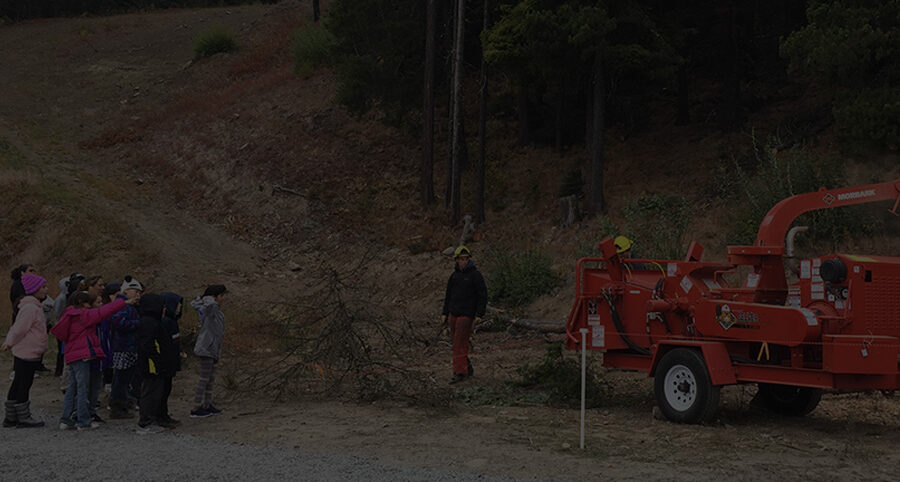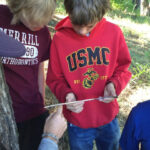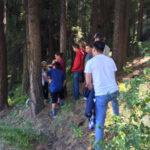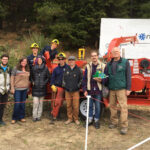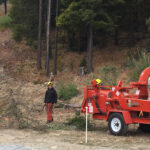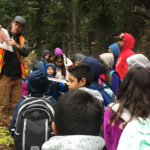…and Out of the Classroom
The Kids in the Forest Project provides teacher training and forest field experiences for 3rd-8th grade students in North Central Washington. This program focuses on forest health and wildfire ecology in an effort to help teachers and students understand the transitional nature of Washington’s eastern forests and shrub-steppe ecosystems. The main goal of Kids in the Forest is for students and teachers to see what healthy and unhealthy forests look like, and how wildfire, climate, and forest management play important roles in maintaining healthy forests.
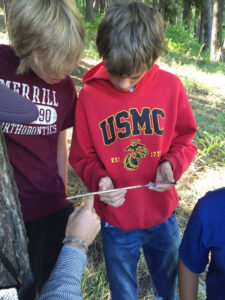
By taking classrooms out on a hike in the mountains, through the gorgeous grand fir and Ponderosa pine stands on the hills around us, we offer a fully immersive experience with nature. In order to care for something, in order to better understand it, we need to see it, feel it, and experience it. By getting kids into forests and teaching them about climate and people affect fire behavior, Kids in the Forest enriches the link between people and forests. We hope that by creating baseline knowledge, students and teachers will learn to talk about forest management and wildfire in their community in a way that supports sustainable approaches to land management.
Each year the program reaches 1,500+ 5th-8th grade students in Chelan, Douglas, Grant, and Okanogan counties! These young minds are experiencing the appreciation of nature and its beauty, and coming away with vital knowledge about what it takes to keep these landscapes healthy and functioning.
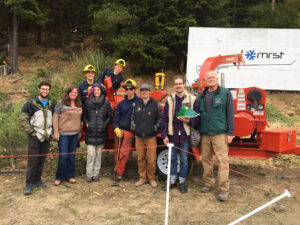
Critical to the success of the program is integrating project partners into the field experience to provide students an opportunity to connect with professionals in the resource management field and ask questions about their jobs and how they got to where they are. Early exposure to natural resource management as a fun, exciting, and realistic career path will help to keep forest management and stewardship of public lands a valued career path in future generations!
Kids in the Forest expanded upon the already successful Forest Classroom program started by the Wenatchee Valley Museum and Cultural Center. Partners who have supported this program include: Wenatchee Valley Museum and Cultural Center, Sustainable Forestry Initiative, Washington State SFI Implementation Committee, Columbia Breaks Fire Interpretive Center, North Central Washington Forest Health Collaborative, Project Learning Tree Washington, the Office of Superintendent of Public Instruction, Wenatchee Art Education Consortium, Chelan County Fire District #1, WA Department of Natural Resources, US Forest Service, Mission Ridge Ski Area, Chelan-Douglas Land Trust, and The Wildfire Project.
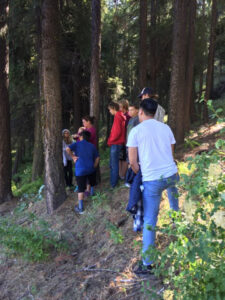
Although educators are excited to have a program that offers their students field experiences, their approach is to take the classes to the sites and allow the site personnel to provide all the education and experiences. This is OK if their only goal is to get the kids excited about being there and to pick up a few bits of interesting information; but it poses a few challenges:
- The best field experiences are those in which the students are seeing what they have already discussed/learned in the classroom. And this depends partly upon the educators’ ability, desire, time, confidence, and knowledge to provide pre and post activities.
- There is not enough time on site to help the students reach an understanding of the concepts that you want them to learn…barely enough time just for an introduction to the complexity of forests and what sustains them. They need to have more time to somehow integrate the concepts into an already overcrowded curriculum. Providing a source of kid-attractive activities and easy-to-understand basic information with the needed materials will facilitate this process.
- The sites often depend upon volunteers and other professionals who are not always available. We want the program to become more sustainable by giving the teachers the capability to become the group facilitators.
To alleviate those challenges, KIF has set as a goal to schedule teacher trainings in the participating districts, and at general Stem conferences. At those trainings we provide participants with easy-to-understand/implement sources of information and activities about basic forest/fire/climate ecology. We provide them with an understanding of the basic storyline: what is there…what are the variables. how have different species adapted to that particular niche/location (especially fire and climate)…how everything is connected…how that balance is interrupted…what role human management has affected the balance…what are the possible solutions that will help provide sustainability/balance…with the understanding that no one solution will work all the time forever. We provide an introduction to the Project Learning Tree curriculum and integrate those activities that specifically relate to climate and fire. Each participant also receives a flash drive with all the activities on it, along with background information that both teachers and students need to understand the basic concepts. This information includes:
- power point productions from local ecology experts
- activities developed over several years by local educators
- videos/programs produced by fire professionals
- downloaded online curriculums such as the Fireworks Curriculum produced by the USFS Rocky Mtn.
Research Station in Missoula, Fire In Pacific Northwest Ecosystems produced by the PNW Wildfire Coordinating Group, and the Kids Crossing In the Classroom: Teaching Earth and Atmospheric Science produced by the National Center for Atmospheric Research.
